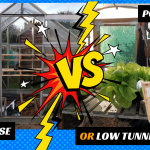Spring has sprung, and the allotment or veggie patch beckons with promises of lush growth and abundant harvests. As you dust off your gardening tools and bask in the warming sun, it’s time to tackle a few essential tasks to set the stage for a successful growing season. Here’s your comprehensive checklist to ensure your plot thrives from springtime through to the bountiful days of summer.
Watch Glen on YouTube for a walk-through of the spring Jobs.
1. Erect French and Runner Bean Canes: First things first, let’s get those climbing beans off to a great start! Erect sturdy supports for your French and runner beans, providing them with the structure they need to climb and flourish. Ensure the canes are firmly anchored in the ground and spaced appropriately to accommodate the vigorous growth of these prolific climbers.
2. Feed Your Blackcurrant Bushes: Give your blackcurrant bushes a nutrient boost by adding blood, fish, and bone meal around their base. This organic fertilizer will provide essential nutrients to support healthy growth and maximize fruit production. Scatter the fertilizer evenly and gently work it into the soil around the bushes, taking care not to disturb their roots.
3. Harvest Leeks: If you overwintered leeks, now is the time to harvest them before they start to bolt. These flavorful veggies are at their peak tenderness in spring, offering a delicious addition to soups, stews, and stir-fries. Harvest leeks by gently pulling them from the ground, taking care not to damage the roots of neighboring plants.
4. Fertilize Tomatoes as They Flower: As your tomato plants begin to flower, it’s crucial to provide them with a boost of nutrients to support fruit development. Apply a balanced fertilizer, rich in potassium and phosphorus, to encourage robust growth and abundant harvests. Water the fertilizer in thoroughly to ensure it reaches the roots of the plants.
5. Protect Gooseberry Bushes from Bullfinches: Pesky bullfinches can wreak havoc on tender gooseberry buds, stripping your bushes of their future fruit. Protect your precious crop by covering gooseberry bushes with netting or fleece, creating a barrier that deters these feathered foragers. Ensure the covering is secure and extends to the ground to prevent access from all angles.
6. Prepare Beds for Direct Sowing: Finally, prepare a bed for direct sowing, laying the groundwork for a cornucopia of homegrown delights. Clear any weeds or debris from the area and loosen the soil to a depth of several inches. Incorporate organic matter such as compost or well-rotted manure to improve soil structure and fertility. Rake the bed smooth and level, ready to receive your seeds and seedlings.
With these essential tasks completed, your allotment or veggie patch is primed for a season of growth and abundance. Embrace the rhythm of the garden, tending to its needs with care and nurturing each plant towards its full potential. Happy gardening, and may your harvests be plentiful!


